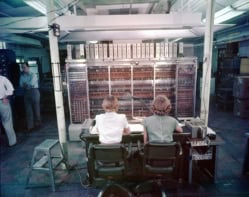By Matin Durrani
Things seem to have quietened down a bit following last month’s announcement by astronomers in the BICEP2 collaboration that they had obtained the first evidence of cosmic inflation – the period of rapid expansion in the first fraction of a second after the Big Bang. As you’ll know if you’ve been keeping up, the evidence was obtained by searching for certain “B-mode” polarizations in the cosmic microwave background, which are related to primordial gravitational waves that are thought to have abounded in the early universe. These polarizations differ from “E-mode” polarization, which describes how the magnitude of polarization varies across the CMB.
But never mind your fancy B-modes and E-modes, how well do you understand the concept of polarization in the first place? Intriguingly, in the late 1840s Sir Charles Wheatstone, who was then professor of experimental philosophy at the University of London, decided to create a mechanical device to explain the principles of the concept – several decades before James Clerk Maxwell’s theory of the electromagnetic nature of light.
The video above shows a rare surviving example of one of these “Wheatstone Wave Machines”, which has been restored to working order by Robert Whitworth and colleagues at the University of Birmingham in the UK as part of their collection of historic physics instruments. Wheatstone designed the machine to visualize the wave nature of light and offer what Whitworth calls “a vivid insight into the theoretical concepts of wave motion”. At the time, there were other devices that showed the behaviour of travelling plane waves, but Wheatstone’s was different in that it was the first to demonstrate circularly polarized light.
Originally built by John Newman of London, the device consists of an array of metal bars tipped with white balls. As Whitworth explains, the bars can be moved up and down or from side to side by wooden sliders that have a wave profile on one side. If you push the sliders through the machine, the balls on the side of the machine move up and down in a vertical plane as a travelling wave that appears to move back and forth.
But there are also balls on the top of the machine and at 2.45 minutes you can see how the two sets of balls – when given a wave motion – can be made to interfere. When the two waves are out of phase, the top balls lie flat, but when they’re in phase, you get a wave of double amplitude.
What’s also interesting about the machine is that you can use a second set of sliders to move the bars horizontally, meaning that you can combine vertically and horizontally polarized plane waves (3.26 minutes). When the waves are in phase, you get a travelling plane wave on a plane inclined at 45° to the vertical. When the horizontal and vertical waves are 90° out of phase, you get a circularly polarized travelling wave – of either right-handed or left-handed nature (4.00 minutes).
In fact, you can do some quite advanced stuff. At 4.25 minutes, Whitworth shows the machine set up with an in-built, right-handed circularly polarized wave on top. If you add a travelling wave that is also right handed you get interference – when the waves are out of phase you get a straight line of balls, but when they’re in phase you get a giant helix of double amplitude.
Then at 5.36 minutes, you can see what happens when you add a left-handed circularly polarized wave to the in-built right-handed wave. The result is a plane-polarized wave, the plane of which can be rotated as the phase of the two waves is changed.
Another nugget I came across while writing this blog is the fact that Wheatstone, who is best known for the Wheatstone bridge – a device for measuring the resistance of an electrical circuit – didn’t actually invent it and in fact never said he did. What he did invent, though, was the concertina. At least if you believe Isaac Asimov’s Biographical Encylopaedia of Science and Technology, that is.



